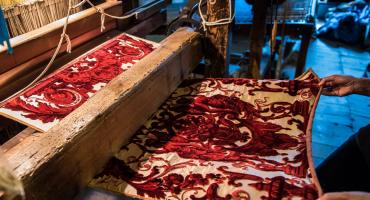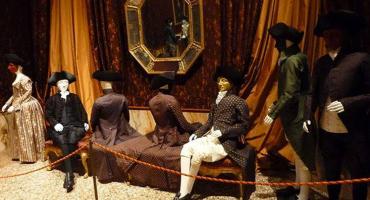This itinerary will take us on a discovery of one of the most ancient crafts in Venice: the art of manufacturing traditional Venetian fabrics. The weaving: art amongst the most noble and ancient ones. Interweaving of threads and colours. Sophisticated manufactured articles like tapestries, carpets and precious textiles already sought after in Medieval Europe.
Let’s think of the production in the city of Arras in the north France (the name “arazzo” – tapestry, comes from it) or of precious fabrics woven in Florence or Venice which, up to mid 18th century knew how to stand up to any competition.
Tapestry had always been considered an important element in house furnishing of rich bourgeois: walls covered in fabric used to protect from cold, they could be easily moved or transported and also became decorations in banqueting halls, churches , field tents and even boats.
1° stage: Our itinerary starts from a historic palace that looks onto Grand Canal: Palazzo Corner, a historic residence of the Queen of Cyprus : Caterina Cornaro and where today there are offices of one of the best known Venetian companies: Rubelli.
It is not difficult to imagine exhilaration that customers can experience when, in this setting, they must choose between precious collection of samples of fabrics this company produces.
A company founded in 1858 by Lorenzo Rubelli, is capable of producing fabrics with any type of thread, using both the most sophisticated machinery and the still functioning looms from 18th century. Its productions of brocades, damasks, velvets, silks and lampases which are unique worldwide, furnish the most beautiful houses in the world as well as the famous world theatres like La Scala and La Fenice and decorate exhibition halls and notable European castles. In Palazzo Corner there is a collection of more than 3,000 textile documents dating back to the period between 15th and 20th century.
This archive, a pride of the Rubelli family, includes documents that come from every part of the world and result to be an indispensable instrument in leading any historical research of philological reconstruction of the textile documents that used to belong to historic residences, museums and embassies from all over the world.
2°stage: Another reference point in the field of ancient fabrics is the one of the Bevilacqua company. It has been present in Venice since 1875 and has also got noble offices overlooking Grand Canal, not very far from Riva di Biasio.
Here there is a collection of its ancient looms in a completely extraordinary atmosphere : it seems as if the time has stopped….the quantity of displayed threads and drawings gives us a clear idea as to how this company managed to achieve such sophisticated and perfect “historical” fabrics to beat any outside competition, even beyond European borders.
3° stage: Venetian creation doesn’t finish here, on the contrary, it widens and gets more modern in the most recent creations accomplished by Roberta di Camerino.
In fact, continuing in the direction of Cannaregio, in another charming Venetian palace situated in a “hidden” Venice, we find Palazzo Loredan Grifalconi, the Curami warehouse(dealers in leather goods, for irony of fate) in the times of Serenissima and now the premises of this famous “made-in-Italy” trademark.
The Roberta di Camerino trademark was born in 1950.
Her handbags are considered by press “the most copied in the world” for their capacity to combine design, colour, elegance and practicality.
In 1960, developing an already tried and tested idea with her velvet hand-woven handbags using ancient Venetian looms, Roberta di Camerino created a line of very innovative and completely original articles using a deceptive technique of painting pattern of trompe l’oeil.
It’s always her who firstly attributes a leading role to an accessory in women’s wardrobe
kaleidoscope of shapes, colours, materials and, above all, an innate class combined with precious materials, first amongst all there is “finely worked velvet”, hand-woven using ancient wooden looms which, according to traditional Venetian technique, gets manufactured in the dark to maintain its uniqueness intact.
4° stage: Talking about fabrics and sophisticated creations, we can not forget great Mariano Fortuny. Spanish by birth, but working in Venice and Venetian “by heart”, he founded the company on the Guidecca island in 1922 and whose story is covered by an air of legend.
A photographer, designer, stenographer and inventor, Fortuny created a completely innovative printing system using a photographic process which is secretive even to this day.
The Fortuny fabrics are dripping with venetianism but at the same time there are a result of a magically successful mixture of cultures, exactly like the spirit of their creator.
Fortyny was one of those very Venetian characters but at the same time a world’s citizen recognized for his indisputable class and refinement as if this talent belonged to all of us since we are inhabitants of this fantastic city and inspired by it.
Today, Mariano Fortuny’s house is part of the civic museums and in a climate of great decadent charm of history of elegance and exclusive research of the beautiful and of pioneering in style and fashion, these can be visited: his tapestries, precious fabrics, lamps, craft equipment, lights that were used to illuminate the theatres throughout Europe, first panoramic cameras with wide-angular lens, his archive of photos of Venice from the end of 19th century, intact and innocent as it had been seen with the eyes of Goethe, Wagner, Byron, Mann, Stendhal, De Balzac, Proust..




